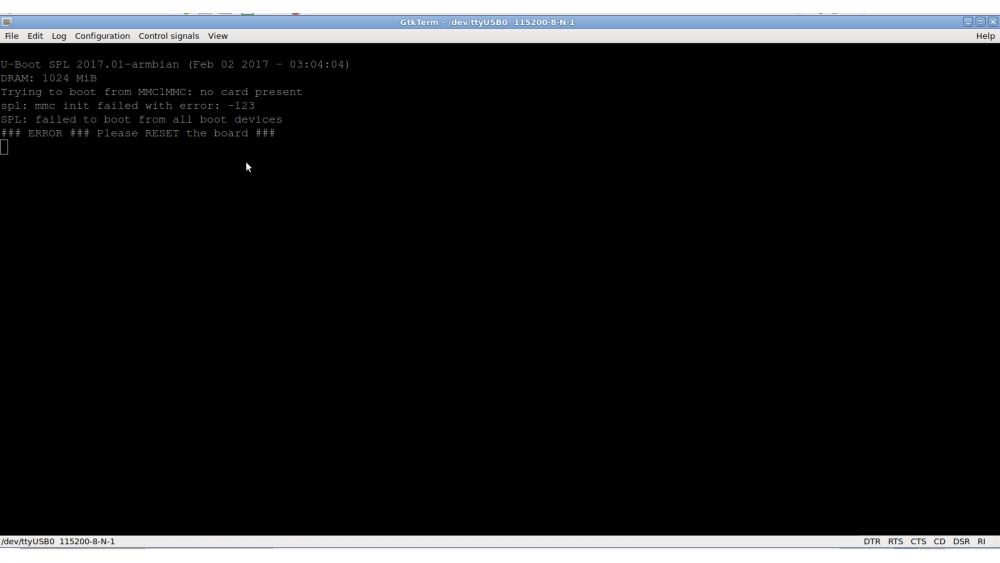-
Posts
22 -
Joined
-
Last visited
Content Type
Forums
Store
Crowdfunding
Applications
Events
Raffles
Community Map
Everything posted by Hugo Cardozo
-

Set properly automount settings for ext4 SATA HDD
Hugo Cardozo replied to Piroskis's topic in Allwinner sunxi
Well, let's clarify a point: BananaPi's "SATA" is more like a "USB-to-SATA" device, so it's not THAT fast. That said, why don't you just keep your fstab the way it is and do a "chown -R <myuser>:<mygroup> /mnt/DataHDD", if you need your regular "myuser" user to do stuff inside of /mnt/DataHDD? -

Debian Stretch Porting and Optimizations
Hugo Cardozo replied to edolnx's topic in Advanced users - Development
WTF...! That's all I can say. Yesterday I've found balbes' instructions for debugging odroid boot (setting ' setenv verbosity "7" ' on boot.ini), and today I've tried again to upgrade to Stretch and install a custom kernel. And it all worked flawlessly! The only thing I've changed was the "verbosity" bit... Anyway, now my Odroid-C2 runs Stretch too. -

Debian Stretch Porting and Optimizations
Hugo Cardozo replied to edolnx's topic in Advanced users - Development
Now I'm using Stretch on most of my boards, and I want to share my experiences. First, some pointers: All my boards are headless servers of some sort (routers, gateways, WAPs, NASes...). I didn't try desktop, video, xorg, anything with graphics When available, I use mainline kernel, be it "next", "dev", or "roll-your-own" through armbian toolchain The boards which are currently running Stretch are: Orange Pi PC Banana Pi M1 Cubieboard 2 Now I'm trying to upgrade my Odroid-C2 to Stretch and mainline, but so far I didn't succeed. As I do not get any output on HDMI nor serial (beyond "Starting kernel..."), I don't know what's wrong... We'll see -

How to backup/transfer Armbian filesystem?
Hugo Cardozo replied to Hugo Cardozo's topic in Beginners
May I ask which flags? "metadata_csum", for example? -

How to backup/transfer Armbian filesystem?
Hugo Cardozo replied to Hugo Cardozo's topic in Beginners
Yes, it worked that way, with some extra work: For some reason, Armbian couldn't boot my ext4-formatted SDcard (I formatted it on a Debian 9 PC, maybe it has something to do with it?) So I've formatted again using ext3 Edit /boot/armbianEnv.txt and /etc/fstab to change root filesystem UUID value, and to change "ext4" for "ext3" in fstab -
From time to time I want to change the SDcards on my boards, for one reason or another. So, in order to transfer the Armbian filesystem I dd from the first sdcard and later dd to the second, a very slow process. I think it would be faster to: Partition and mkfs the new sdcard Copy/tar/rsync the armbian filesystem But no board won't boot that sdcard. So I'm missing a crucial step, maybe it has something to do with u-boot?
-

Armbian for Orange Pi + does not boot
Hugo Cardozo replied to Hugo Cardozo's topic in Allwinner sunxi
Hello, recently I've messed up the armbian installation in my OPi+. So I wanted to try again booting from microSD, with the latest armbian available (5.25 as of today). It still does not work. I got the "debian jessie mini" image from Loboris' site (http://www.orangepi.org/orangepibbsen/forum.php?mod=viewthread&tid=342), and after boot it I could dd the armbian image directly on OPi+ eMMC. -
Doubtful. If you get it working, you'll be doing something like this: Windows app -> Windows emulator -> x86 emulator -> Linux on ARM I believe it would be extremely slow per-se, then you must account for the low specs of most ARM boards (the OPis are not that powerful either). Not very practical IMHO
-
Hello, I'm trying to upgrade Armbian on my little OrangePi Lite, and it's been 3 days at it already. It is stuck at "Compiling headers", and it is not hung, I can use it. It does happen from time to time to all my SoCs, sometimes I prefer to re-dd and reconfigure. So I was thinking, if compilation cannot be avoided, can it be done on another computer? Cross-compile?
-

Can we stop for a second and give credit due to the Armbian posse
Hugo Cardozo replied to DrTune's topic in Beginners
I do donate a couple of bucks from time to time. But maybe not enough times, I think, seeing I'm using armbian on almost 10 boards (cubies, bananas, oranges, odroids...), some of them for work. I'm really glad Armbian exists and thrives. -
I downloaded an orangepi.org image, flashed it to SDcard, booted it, login from serial console, and then I flashed an Armbian image directly to OPi+ eMMC # dd if=<armbian.img> of=/dev/mmcblkX I had the Armbian image on another USB thumb drive, and OPi+ has a lot of USB ports.
-
Don't know about OPi PC+, but this is how I installed Armbian on my OPi+ eMMC http://forum.armbian.com/index.php/topic/2125-armbian-for-orange-pi-does-not-boot/ Maybe your OPi can boot Armbian off a SDcard and then flash eMMC, that would be easier, but I don't know about that.
-
Maybe an dd if=<eMMC drive> of=<SDcard> ? You're not giving much information about what do you want to do / what you're trying to achieve
-

Armbian for Orange Pi + does not boot
Hugo Cardozo replied to Hugo Cardozo's topic in Allwinner sunxi
It didn't work, results attached. First I thought that, after I flashed Armbian on eMMC, my OPi+ won't boot a SD card anymore, just like Odroid-C2. But the orangepi.org images can boot from SDcard -

Armbian for Orange Pi + does not boot
Hugo Cardozo replied to Hugo Cardozo's topic in Allwinner sunxi
Hi! I've managed to make Armbian boot. One of orangepi.org images could access the internal eMMC, so I thought that I could flash/boot that image, and then flash Armbian directly on eMMC. And that did the trick! Now my new OPi+ runs Armbian. A tricky workaround, but it worked, so what the heck -

Armbian for Orange Pi + does not boot
Hugo Cardozo replied to Hugo Cardozo's topic in Allwinner sunxi
-

Armbian for Orange Pi + does not boot
Hugo Cardozo replied to Hugo Cardozo's topic in Allwinner sunxi
Will try that, thanks -

Armbian for Orange Pi + does not boot
Hugo Cardozo replied to Hugo Cardozo's topic in Allwinner sunxi
Hello, according to Aliexpress page it is: https://www.aliexpress.com/snapshot/8037872883.html?orderId=77866093680184 -
Hello, I'm trying to boot an Orange Pi Plus with Armbian 5.20, and it does not work. I've already check that both OPi and my sdcard work fine, because I can flash and boot the images on orangepi.org site. Besides, I checked how u-boot starts with both Armbian and "debian server" orangepi.org image (both attached)
-

ARMBIAN for Amlogic S905 and S905X (ver 5.44 =<)
Hugo Cardozo replied to balbes150's topic in General Chat
I'm using my Odroid-C2 as a gateway, with an ASIX88772-based USB-Ethernet dongle, and I get those messages too, so I think they're related to the dongle. -
Somewhere on ODROID's forums I've read that C2 always try to boot eMMC first, and there is no way to change that behavior. So I suppose you could try to: Flash Armbian on both your eMMC and SD card Install both on your C2 Then fidget with the eMMC "/boot/boot.ini" so you use the SD card as root device If you succeed, maybe you could consider delete everything on the eMMC except for the /boot dir, so you can reclaim its capacity back? I did something like that with Armbian, some OrangePi/BananaPi, some SDcards and a couple of USB flash drives/SATA hard drives.









